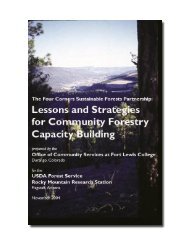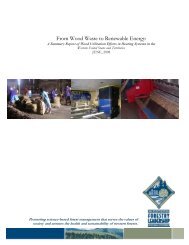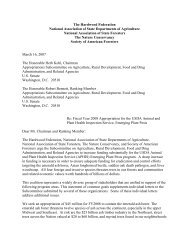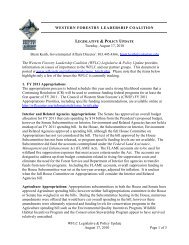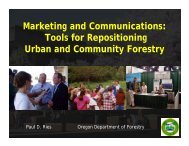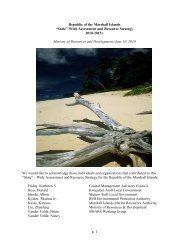Emission Controls for Small Wood-Fired Boilers - Western Forestry ...
Emission Controls for Small Wood-Fired Boilers - Western Forestry ...
Emission Controls for Small Wood-Fired Boilers - Western Forestry ...
Create successful ePaper yourself
Turn your PDF publications into a flip-book with our unique Google optimized e-Paper software.
exhausted. This process may include not only add‐on technology but combustion process modifications<br />
and changes in fuel specifications.<br />
The study described by this report builds upon the 2001 report, but differs in that its goal was not to<br />
identify a single Best Available Control Technology (BACT). Rather, its goal was to identify multiple<br />
emission controls in order to provide more flexibility in the design process <strong>for</strong> biomass combustion<br />
systems. This is because there are many factors affecting the degree of control needed to meet the<br />
National Ambient Air Quality Standards (NAAQS), which were promulgated by EPA to protect human<br />
health and welfare.<br />
Regarding the NAAQS, we note EPA significantly strengthened the NAAQS <strong>for</strong> PM2.5 (aka fine particulate<br />
matter or particles less than 2.5 micrometers in aerodynamic diameter) in 2006. PM2.5 consists of solid<br />
particles and liquid droplets less than 2.5 microns in aerodynamic diameter and is widely held to be the<br />
most critical pollutant resulting from biomass combustion. For comparison, the average period at the end<br />
of a sentence is approximately 500 microns in diameter. 1 Concern <strong>for</strong> health impacts from PM2.5<br />
exposure coupled with the strengthened PM2.5 NAAQS has led to a much greater emphasis on emission<br />
control than in previous years.<br />
The need to develop environmentally beneficial uses of low grade timber, improve <strong>for</strong>est health, mitigate<br />
climate change, offset rising fossil fuel oil prices and reduce <strong>for</strong>eign oil dependence have increased<br />
demand <strong>for</strong> biomass energy systems. Given frequent budget limitations, biomass developers are pressed<br />
to find cost‐effective ways to reduce emissions of PM2.5 and other pollutants. In addition to being<br />
af<strong>for</strong>dable, emission controls must be practical and easily implementable, otherwise they will not be<br />
effective. This study was commissioned by the U.S. Forest Service (USFS) to identify and evaluate such<br />
emission controls.<br />
This report contains the following sections:<br />
• Scope of study<br />
• <strong>Emission</strong>s overview<br />
• Best Management Practices (BMPs)<br />
• Add‐on pollution controls<br />
• Summary of European emission control practices<br />
• Capital costs <strong>for</strong> particulate matter control<br />
• Cost effectiveness of add‐on emission controls <strong>for</strong> particulate matter<br />
• Overview of emission controls <strong>for</strong> other relevant pollutants<br />
• Summary<br />
• Conclusion<br />
• Recommendations<br />
The use of trade or firm names is <strong>for</strong> in<strong>for</strong>mation only and does not imply endorsement by the authors or<br />
this study’s sponsor.<br />
1<br />
“Health Effects of <strong>Wood</strong> Smoke.” Washington State Department of Ecology. http://www.ecy.wa.gov/biblio/92046.html<br />
Resource Systems Group, Inc.<br />
<strong>Emission</strong> Control Technologies <strong>for</strong> <strong>Small</strong> <strong>Wood</strong>‐<strong>Fired</strong> <strong>Boilers</strong><br />
6 May 2010 Page 2



